Strawberries
What Kind of Bug is This?
We experienced some excitement this past week when we found a unique looking bug out of one of our samples in a spotted wing drosophila trial in strawberry. Have a look at it yourself - lots of spines all over and a swollen pair of first legs.
Kirsten ascertained that this is an assassin bug of the family Reduviidae, most likely of the genus Sinea because of the spines and those large first legs. We've included below a general picture of this genus from the web.
According to the UC IPM guidelines, generally both the nymphs and adults of assassin bugs feed other insects like caterpillars, larvae of leaf beetles along with the nymphs and adults of other true bugs (think lygus). They capture their prey by ambush or stalking, followed by impaling it with their tubular mouthparts, injecting a venom and then sucking out the bodily contents.
Since we know people are wondering, assassin bugs, although impressive in appearance and feeding tactics, are too general in their predation to be considered important predators like big-eyed bugs or minute pirate bugs. That said, finding such unique predators may be a good sign of a field that supports a robust and diverse predator community. High predator diversity can be a valuable defense against pest outbreaks.
In the berries, it's a something like a box of chocolates, you just never know what you might find!
Link to UC IPM article on assassin bugs:
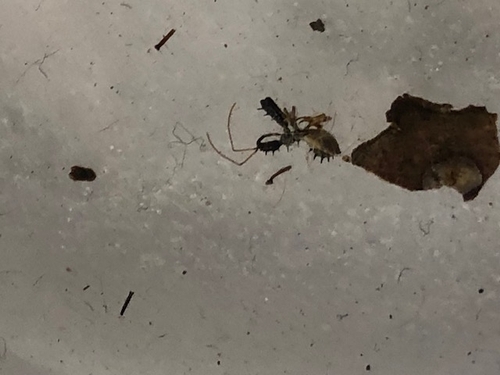
Assassin bug found 8-22-2023 in strawberry north of Watsonville.
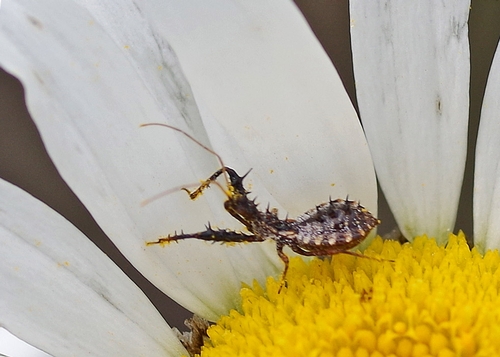
Spined assassin bug nymph. Photo UW, Milwaukee
Is the Juice Worth the Squeeze? Some Notes on the Utility of Seaweed Extracts in Berry Production on the Central Coast
Over the past year, I've had questions brought to me about the usefulness of seaweed extracts in the strawberries and caneberries of the Central Coast. Namely, are these extracts actually adding any benefit or value, and if so what precisely are they doing and how are they doing it?
It thus has been my good fortune to find in a colleague's library the book Seaweed and Plant Growth by Dr. T.L. Senn pictured below. While it was published a while ago, it nonetheless has provided me with a good foundation on the subject of seaweed extracts and their applicability to plant agriculture, a foundation upon which we can explore a bit about the possibilities these could offer berry growers on the Central Coast.
To begin, a lot of work has been done on the extracts of seaweed, in this case the marine alga Ascophyllum nodosum, which has been available to agriculture since at least the 1950's and is the main ingredient in many of the seaweed extracts on hand for growers on the Central Coast. Available as a soluble powder or liquid concentrate, these formulations contain a number of plant growth regulators, in particular cytokinins.
Cytokinins are hormones found in the rapidly dividing cells of plants, which generally are found in the tips of the roots and plant tips associated with bud initiation. The effects of these particular hormones, in concert with some of the other plant growth regulators found in the seaweed extracts are various, and I give a summary of them here:
Growth promotion, improved flower set and higher fruit yield: Since many of the plant hormones including the cytokinins are found in the actively growing points of the plant, it should not be surprising that certain studies have found increased rate of growth and inflorescence formation. For example, foliar application of seaweed extract in bananas resulted in faster shoot formation and heavier bunches; another study at the Connecticut Agricultural Research Station found significant increase in fruit spur formation in two varieties of apple following seaweed extract sprays when compared with unsprayed trees.
Looking to more recent literature in strawberries, a series of trials run over six years in Oxnard by a private research contractor showed that drip tape applications of an A. nodosum extract improved fruit yield by an average of 400 ten pound boxes per acre. This was attributed by the researcher to improvements in early plant growth and development, along with more tolerance to environmental stresses such as soil disease. These results from Oxnard were mirrored in a later study in strawberry in Australia.
Improved shelf life: The deterioration of fruit which takes place in storage is linked to an altered balance of hormones in the plant before harvest and the fruit once picked. The deterioration of fruit has in trials been delayed by the use of seaweed extracts, especially those with a lot of cytokinins like A. nodosum which apparently go some measure to restoring a more beneficial hormonal balance.
Results can be impressive, the book cites a remarkable trial in cucumbers where shelf life was improved by 14 to 21 days by treating the producing plants weekly with seaweed extracts; an increase of the shelf life in peaches was also realized following a similar program of regular application of extracts to bearing trees.
Micronutrient utilization: There is evidence given that the application of seaweed extract facilitates micronutrient uptake, either through chelation or improved plant metabolic activity, by plants. For example application of seaweed extract to tomatoes resulted in more manganese in the leaves of treated tomatoes than those of the untreated, and to levels beyond that of what was in the extract. Another study growing peppers with a mineral deficient fertilizer mix augmented with seaweed extract resulted in improved utilization of boron, copper, iron, zinc and manganese.
So, what do make of all of this? I think that while there are positive results, sometimes really eye opening results, cited here, we should consider the wide range of effects on an even wider range of commodities and also the cases where nothing happened at all. That many of these studies were run decades ago, but the use of seaweed extracts has yet to be widely adopted tells me that the effects are not always repeatable. This lack of consistency is not surprising to me, especially with hormones whose effects, unlike fertilizers or pesticides, are modulated by a wide range of factors and certainly don't function under a "more is better" paradigm.
It's complicated stuff here, and I think it would almost need to be pursued on a custom basis, farm to farm. The trials for what to do on each farm are not complicated to run, but one would have to commit to the work for several years to really figure out if they would make a positive contribution into the operation and worth putting into one's production program.
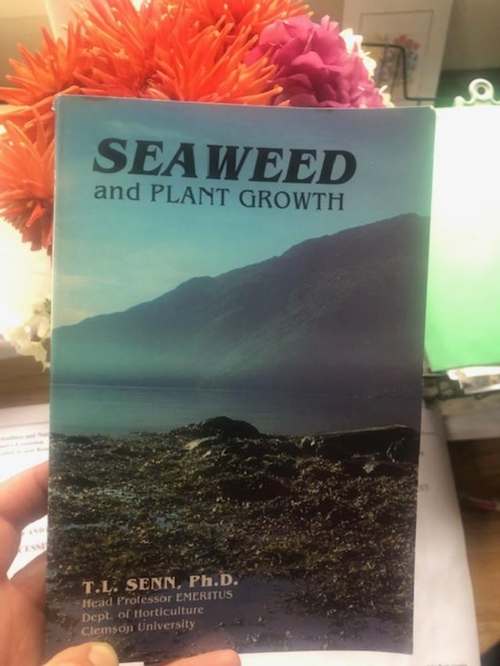
thumbnail
Flower abortion in Central Coast Strawberries
There have been many, many questions over the past few weeks about why so many strawberry flowers are aborting in addition to a noticeable uptick in crooked, mis-shapen fruit. So, while I cannot present any empirical evidence as to why more strawberry flowers than usual are failing, in the interest of offering information that could be helpful I can share some of my own hypotheses.
There are several reasons for the failed flowers, better known by growers and crop managers as aborted fruit or duds. These aborted flowers are flowers with blackened centers (see the photos attached below) which are the dead floral reproductive parts and subsequently will no longer make as a fruit. Most commonly this is the result of extended period of very high temperatures (roughly above 90o F) or, for certain varieties, the higher ultraviolet radiation (UV) of the longest days of the year at the end of June.
This past year has been different since we have not had very hot days so far and it has been often quite cloudy or foggy all the while that there has been a remarkable amount of fruit loss attributable to aborted flowers and mis-shaping. This indicates a different reason than the excessive heat or UV radiation described above, and from the situations of failed flowers that have been shared with me I am thinking there is a weakening of the plant from a lack of nitrogen nutrition at cause here. In addition to plants which appear less green, tissue samples that I have seen associated with failing flowers have had leaf blade nitrogen under the recommended 2.5%, and soil nitrates under the 10 ppm (sometimes even at 1 or 2 ppm) which is often seen as a minimum for good strawberry plant performance.
I am certain that these low levels of nitrogen in the soil and the plant clearly have a direct relation to the leaching effects of the heavy rains and flooding of this past winter. What's more, this would account for the description many growers and industry personnel share with me of “tired” or “worn out” plants with light green leaves, a lack of vigor and little of the bright green leaf luster that we all associate with a strong and healthy plant.
In turn, the call for additional nitrogen to correct these deficiencies would not be a bad one, and could very well minimize the amount of flower abortion as well.
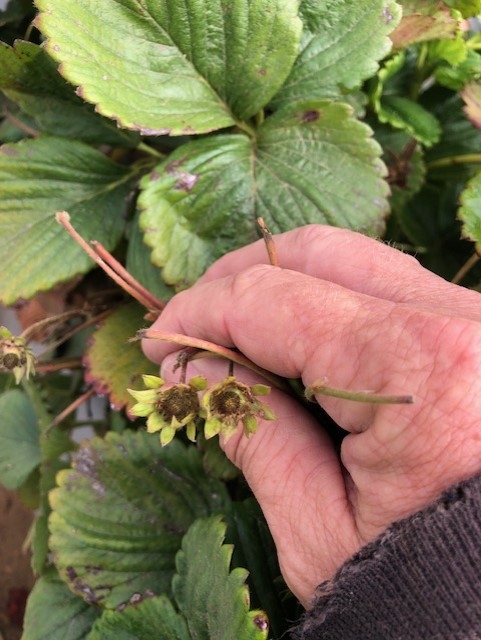
A look at a couple of failed flowers, note burnt out appearance of floral parts.
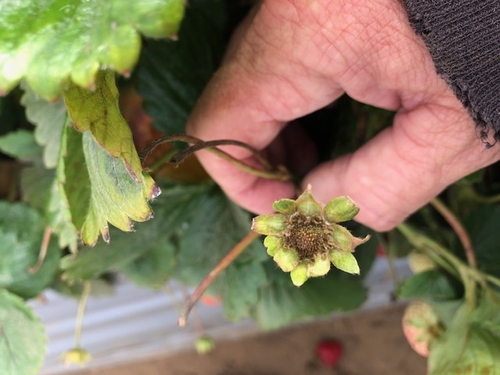
A closer look at an aborted flower.
A Comment on Biological Solutions for Central Coast Agriculture
With a large event concerning biological solutions for agriculture taking place this week in Salinas, I feel it is a good time to make a comment regarding the research taking place here. I started working with these materials in 2012, and have off and on tested them since, for the most part in strawberries.
To open, I will state that while these technologies in theory offer a lot of promise, we don't want to get over our skis with this because that promise has not yet been realized.
Most of my work with biological solutions has been with biological fungicides, so I will make the following points:
- The biological fungicides should not be seen as replacements for preplant treatments such as soil fumigation. I have yet to see any one product come even close in efficacy to soil fumigation and would be quite comfortable betting very serious amounts of money with anyone who feels otherwise. They could be an interesting element of an Integrated Pest Management program, but not as a stand-alone replacement for soil treatments such as fumigation.
- People need to be realistic about how long it's going to take to really learn how to use these biological materials. I am working on a farm in Santa Cruz County with USDA microbiologist Nick LeBlanc and UCCE Plant Pathologist Yu-Chen Wang studying two promising biological materials to understand not only what these materials do, but also how they do it (in other words what are they doing to the plant and the surrounding soil) and for our team of three to run more than the one trial a year we are currently doing would be a real strain for us; remember that it's not just the regular injections of material and data collection, but also preparation for each task and getting to and from the test site. All of us are very busy with other things. If there is a big push from the state or a major agency to work more on biologicals, maybe that would change; it's certainly interesting work and we three would get good publications out of it, but I doubt that the deliverables to the farmer would be very large.
- Time and time again, my colleagues and I have seen, with certain products and not others, a boost in plant performance (like fruit size and yield), especially early, but never anything like a defense against a disease. It's remarkable that products that are completely different, as in a bacterium or a fungus, have the same outcome on the plant. This common thread in effect on the plant is something we are thinking about and looking at closer; at this point we aren't really interested in enhancement in disease resistance because that has not actually shown itself in the field.
What I have written above is a summary of where we stand currently our research with them on the Central Coast. The principle that these biological solutions should work is very compelling and we are not going to give up anytime soon, but it will take time and effort to really understand them and how they will fit into our farming here.
Metallica's James Hetfield Guitar Center Interview - On Stagecraft
A fact of extension work is that you do a lot of presentations in front of audiences, and for people who take it seriously it is a challenging yet very rewarding aspect of the work.
I think that what (starts at minute 9:26, I've set it to start there for you) James Hetfield of the rock band Metallica is saying here puts very much into words what I feel myself when doing a presentation. Not to say the audiences to which I present are anything close to what he and his band play to, including probably the largest crowd of people ever assembled in history, some 1.6 million people at a show in Moscow in 1991, I still find his " sense of purpose, sense of being, sense of communication" to really capture the feeling of what it is like to be performing in front of a group of people. Too, the distinction a bit later on of how one acts in front of a large crowd as compared to being with smaller, more intimate group is spot on, although not that many people in the presentation business really pay attention to that.
Also, look at the light in James' eyes when he talks about playing and performing, he truly loves his work.

